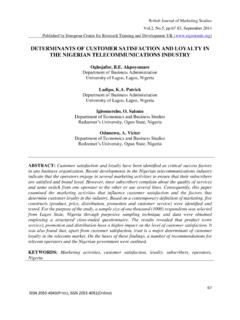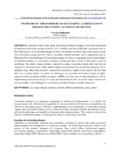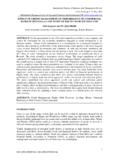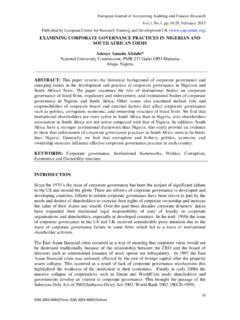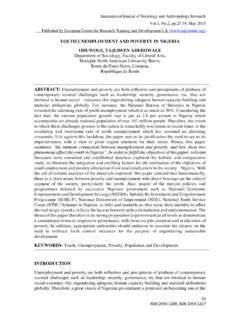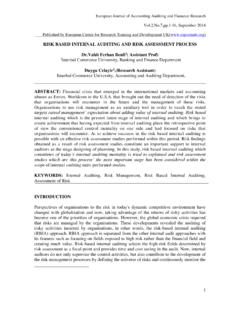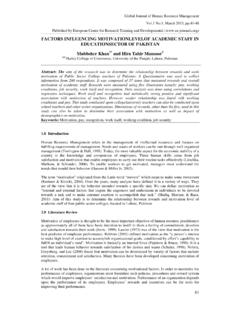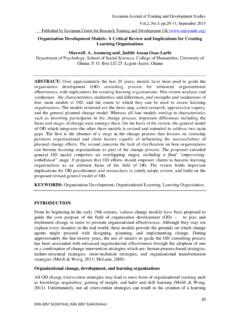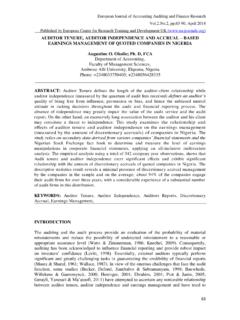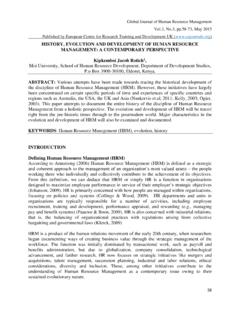Transcription of RELATIONSHIP BETWEEN FINANCIAL INCLUSION AND …
1 International Journal of Small Business and Entrepreneurship Research , , , December 2015 ___Published by European Centre for Research Training and Development UK ( ) 17 ISSN 2053-5821(Print), ISSN 2053-583X(Online) RELATIONSHIP BETWEEN FINANCIAL INCLUSION AND ECONOMIC GROWTH IN NIGERIAN RURAL DWELLERS. Dr. Nwanne, T. F. I. , HCIB Department of Accounting/Finance, Faculty of Management and Social Sciences, Godfrey Okoye University, Enugu. ABSTRACT: FINANCIAL INCLUSION as the provision of a broad range of high quality FINANCIAL products such as savings, credit, insurance, payments and pensions, which are relevant, appropriate and affordable for the entire adult population especially the low income segments of the economy. This study critically examines the sustainability of FINANCIAL INCLUSION to rural dwellers in Nigeria using descriptive study and content analysis. The study observed that the sustainability of FINANCIAL INCLUSION to rural dwellers in Nigeria remains the mainstream for economic growth in any country.
2 The implication of this study is that economy cannot grow fast without proper implementation of FINANCIAL INCLUSION to rural areas in Nigeria. The study recommended that the promotion of collaboration BETWEEN Deposit Money Banks (DMBs), Microfinance Banks (MFBs) and Communication services providers for enhanced intermediation of FINANCIAL services should be encouraged; there is need to educate rural dwellers on the importance of banking as it would facilitate the success of CBN FINANCIAL INCLUSION policy and that since some of the rural dwellers preferred to keep money under their pillows at home, there should be proper enlightenment to change their orientation on FINANCIAL INCLUSION in Nigeria. KEYWORDS: FINANCIAL INCLUSION , Rural Dweller, Economic Growth, Savings, Credit. INTRODUCTION The issue of access to FINANCIAL services for the rural dwellers in every country in terms of development, poverty reduction, decent work and economic empowerment has received growing attention from scholars and policy makers as it concern FINANCIAL INCLUSION .
3 In Banking and Finance area, FINANCIAL INCLUSION can be seen as the delivery of FINANCIAL services at affordable costs to some disadvantages and low income segment of the economy, in contrast to FINANCIAL exclusion where those services are not available or affordable. Enhancing FINANCIAL Innovation and Access (EFInA) (2013) define FINANCIAL INCLUSION as the provision of a broad range of high quality FINANCIAL products such as savings, credit, insurance, payments and pensions, which are relevant, appropriate and affordable for the entire adult population especially the low income segments of the economy. FINANCIAL Access Initiative (FAI) has estimated that billion adults, just over half of the world s population, do not use formal FINANCIAL services to save or borrow. 62% of adults, nearly billion, living in Asia, Africa, Latin Africa and Middle East are un-served.
4 A little more than 800 million live on less than $5 per day. Nigeria is not exception with a large population of financially un-served people put at in 2010 (EFInA, 2010 in Paul, 2013). In Nigeria, there are many reasons why unbanked and lack of access to FINANCIAL services especially the rural dwellers prevail. The result of the EFInA to FINANCIAL Services in Nigeria International Journal of Small Business and Entrepreneurship Research , , , December 2015 ___Published by European Centre for Research Training and Development UK ( ) 18 ISSN 2053-5821(Print), ISSN 2053-583X(Online) 2012 survey showed that million adults representing of the adult population were FINANCIAL excluded. This means that only million adults were banked representing of the adult population (EFInA, 2013). FINANCIAL INCLUSION is critical to the attainment of poverty reduction, removal of barriers to economic participation of rural dwellers, women, youths and those at the bottom of poverty.
5 It is also focused on improving FINANCIAL education for rural dwellers. FINANCIAL INCLUSION will help pave way for sustainable economic growth by providing FINANCIAL services to individuals and communities that traditionally have limited or no access to the formal FINANCIAL sector as evidenced in Nigerian rural dwellers. Meanwhile, this study is meant to evaluate the sustainability of FINANCIAL INCLUSION on rural dwellers in Nigeria. REVIEW OF RELATED LITERATURE Concept of FINANCIAL INCLUSION The traditional idea of FINANCIAL INCLUSION is the provision of access to and usage of diverse, convenient, affordable FINANCIAL services. Access to and use of FINANCIAL services is one of the major drivers of economic growth. FINANCIAL INCLUSION covers sustainable, relevant, cost-effective and meaningful FINANCIAL services for the financially underserved population especially rural dwellers.
6 Wikipedia (2013) define FINANCIAL INCLUSION as the delivery of FINANCIAL services at affordable price and terms to the generality of the populace especially the disadvantaged and low income segment of the society. Centre for FINANCIAL INCLUSION (2013) sees FINANCIAL INCLUSION as a state in which all people who can use FINANCIAL services have access to a complement of quality FINANCIAL services, provided at affordable prices, in a convenient manner and with dignity for the clients. Consultative Group for Assisting the Poor, FINANCIAL INCLUSION means that households and businesses have access and can effectively use appropriate FINANCIAL services. Such services must be provided responsibly and sustainably, in a well regulated environment. The Reserve Bank of India defines FINANCIAL INCLUSION as the process of ensuring access to appropriate FINANCIAL products and services needed by vulnerable groups such as weaker sections and low income groups at an affordable cost in a fair and transparent manner by mainstream institutional players.
7 The importance of FINANCIAL INCLUSION derives from its impact on livelihood. In Hariharan and Marktanner (2012), FINANCIAL INCLUSION is a huge prerequisite for economic growth and development based on its ability to enhance capital creation, FINANCIAL sector savings and intermediation and by implication investment. In the view of Khan (2011), FINANCIAL INCLUSION improves the FINANCIAL status and standard of living of the poor and vulnerable, as it enables them to increase their engagement in economic activities, increase wealth and support employment of household members. World Bank (2012) sees FINANCIAL INCLUSION as the range, quality and availability of FINANCIAL services to the underserved and financially excluded. United Nation Development Programme (2013) defined FINANCIAL INCLUSION as an inclusive FINANCIAL system that services all clients reaching out to poor and low-income people and providing them with affordable FINANCIAL services tailored to their needs.
8 Nigerian F I Strategy (2013) stated that FINANCIAL INCLUSION is achieved when adults have easy access to a broad range of formal FINANCIAL International Journal of Small Business and Entrepreneurship Research , , , December 2015 ___Published by European Centre for Research Training and Development UK ( ) 19 ISSN 2053-5821(Print), ISSN 2053-583X(Online) services that meet their needs and are provided at affordable cost. Bank of India (2012) defined FINANCIAL INCLUSION as the delivery of FINANCIAL services at an affordable cost to the vast section of the disadvantaged and low income groups. Okafor (2012) observed that FINANCIAL INCLUSION accelerates the flow of credit to small-scale enterprises, which serves as a new engine of sustaining small- scale enterprises growth and balance development, because credit provides a significant source of employment and income to the rural dwellers.
9 Goodland, Onumah and Amadi (2012) and Yaron, Benjamin and Piprek (2013) reported that FINANCIAL INCLUSION enhances efficient allocation of resources through FINANCIAL intermediation. FINANCIAL intermediation is the movement of money from those who have an excess to those who have shortage. The movement of money to those who make use of it improves resource allocation efficiency especially in rural areas. Dia (2006) (cited in Goodland 2012) opined that such transfer results in a more equitable distribution of incomes; with transfer being used for health and education which increase the access of the poor to these services/investment. Afolabi and Osota (2009) and World Bank (2012) also argued that it improves ownership patterns which impact positively on the productivity and status of the poor. Clark (2013) further asserted that FINANCIAL INCLUSION helps people to diversify or increase income stream in the house, provides liquidity/cashflow; absorbs shock of adversity by building assets which enables client to cope with loss through consumption smoothing, thus avoiding the sale of productive assets.
10 It increases income when the credit is used for an income-generating activity and that activity generates returns in excess of the loan installment repayments, while it builds asset when the credit-financed investment does not generate a significant net profit but create an asset since the investment remains with the clients. The World Bank (2013) asserted that FINANCIAL INCLUSION in about 398 villages in rural area in Niger Republic accounted for 84 per cent of total loans in that villages and was equal to 17 per cent of income of these rural dwellers. Importance of FINANCIAL INCLUSION on Rural Dwellers in Nigeria The enterprise is at the heart of sustainable development and the necessary impetus must be given to the creation and development of rural dwellers enterprises. In recent years most jobs have been created by small and medium sized enterprises. Affirmative action programmes in self-employment, entrepreneurial skills development and small and medium enterprise development are strongly recommended because they are significant for at least three related reasons: they represent a potentially viable alternative to wage employment; sometimes such employment better enables rural dwellers to combine work with their reproductive role especially family responsibilities; and because the successful development of rural dwellers owned enterprises will determine whether the informal sector is a sector of last resort.
